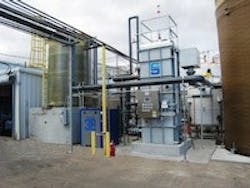Protecting Carbon Columns
A chemical plant located in the southeast produces insecticide, herbicide and fungicide products packaged under various labels for major chemical companies. These products are marketed for sale in the U.S. and overseas. Due to the toxicity of these types of chemicals, the plant captures and treats all storm water that has the potential to contact any of the production areas where these chemicals are produced. These measures are required because some of these compounds can be toxic at part per trillion levels.
Storm water that has the potential to contact the production areas is controlled by a series of berms to keep the water from leaving the property. A series of sumps and underground pipes routes the storm water to be treated into two 20,000-gal carbon columns that are run in series. Since all of the production areas are surrounded by a berm, any sediments or particles in these areas are also collected and routed to the treatment system. The material collected increases suspended solids sent to the storm water treatment system (SWTS), reducing efficiency of the process.
The facility permit requires testing the storm water to ensure certain chemicals are being removed. In addition to more typical parameters like biological oxygen demand and total suspended solids, the plant is required to conduct bio assay testing, which determines whether the water is toxic to fathead minnows and cero daphnia. Over the previous three years, testing indicated that some of the compounds were not completely captured by the carbon columns.
EnSafe Inc., an environmental engineering and consulting firm, was hired to evaluate and remediate the existing storm water processing system. Brian Derry, a senior chemical engineer in EnSafe’s Jackson, Miss., office, was appointed project manager to oversee the design and installation of the system.
Historical data showed that the carbon columns were frequently becoming fouled with suspended solids, greatly reducing system effectiveness and requiring increased maintenance. Also, the major component causing toxicity in the storm water was a category of chemicals called pyrethroids. Pyrethroids were adsorbing onto suspended solids and later desorbing back into the storm water after passing through the carbon columns. The accelerated fouling, due to the accumulation of suspended solids, required more frequent backwashing of the carbon beds to regain column efficiency.
The Solution
The Schreiber Fuzzy Filter was proposed as a solids removal step to control pyrethroids and to reduce fouling of the carbon columns. The Fuzzy Filter was selected for several reasons as follows:
- • It employs a bed of compressible media that enables changes of media pore size by adjusting a movable compression plate.
- • The limited space available for installation of a filtration device favored the Fuzzy Filter, which operates at approximately four to five times the flux rate of sand and multi-media type filters. This results in an equipment footprint requirement of 25% of other solid media type filters.
- • Media backwashing employs influent (no clean water required) that eliminates the need for extra backwash pumps and a backwash storage vessel. Backwash volume is a fraction of that used by hard media filters, averaging around 1%.
- • A compressible media life of 10 years plus is twice the life of hard media, reducing maintenance expense.
The first step was to pilot test this application. In June of 2010, a trailer-mounted pilot filter system was installed near the carbon columns and adjacent to the storm water collection sump. Testing was performed to establish the optimum operating parameters for this application. Media compression was evaluated to determine the minimum pore size and compression setting necessary to remove suspended solids from the storm water. The testing demonstrated that the filters could capture a significant portion of the suspended solids without the use of coagulants and polymers. The filter media is capable of removal of suspended solids down to 4 microns.
After successful pilot testing, EnSafe developed a flow sheet for the improved SWTS and then performed detailed engineering to transform this concept into a reality. As an additional precaution, a chemical pretreatment system was incorporated prior to filtration to coagulate particles to greater than 4 microns for removal by the Fuzzy Filter. Filter backwash is collected and treated for disposal. The system was installed in mid-2011 and placed in operation in November 2011.
Outside of taking longer to optimize the system to achieve the design flow rates (due to the lack of storm events), the system is working as planned. The facility has not experienced any compliance issues with its bio assay testing, which indicates that the goal of removing pyrethroids and protecting the carbon limiting solids from reaching the carbon was achieved.
Brian Derry is a principal for EnSafe. Derry can be reached at [email protected]. Bill Kunzman is vice president of business development for Schreiber LLC. Kunzman can be reached at [email protected].
